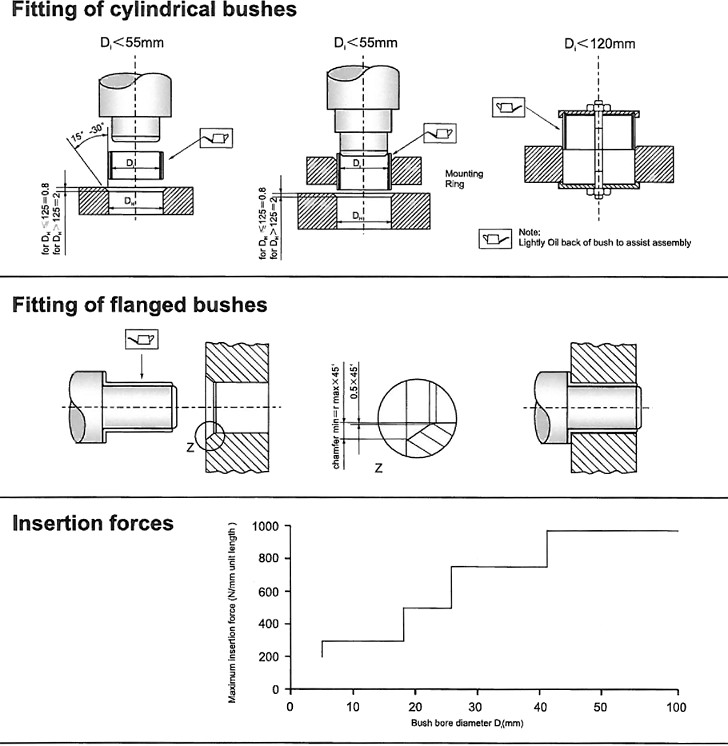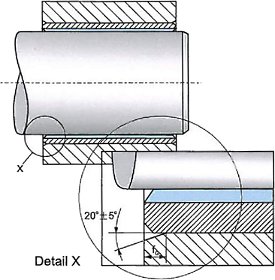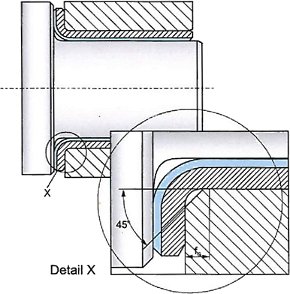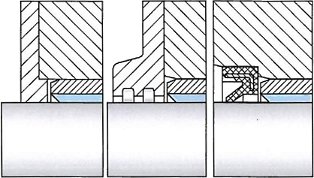Bushings and Plain Bearings - Fitting and Mounting
This Technical Information Sheet covers bushing fitting and mounting topics including: bushing installation, run-in period, storage, thrust washers and plate, alternative fixing methods, housing, shaft, and seals.
Bushing Installation

For some special applications, such as AST650 bushings, the shrink fitting method could be taken into consideration. This is the preferred method for inserting a bushing into its housing providing an optimum interference fit without the risk of bearing damage during installation. Frozen CO2 should be packed around the bearing for up to 2 hours, depending on the cross section of bushing. Once removed from the CO2, the bushing should be place into its housing without delay. It should fit without force and gravity will usually be adequate for a vertical installation.
Run-in Period
During initial run-in, contact surfaces of shaft and bearings are very smooth; however, microscopic irregularities will develop after continuously running for a certain period. A deviation from true center alignment may also exist. Therefore, partial initial contact between sliding surfaces could occur. It is not recommended to immediately start a regularly loaded operation, as this may result in damage to the bushing contact surface, leading to a shorter service life. It is suggested that a gradual break-in operation be performed to sweep out the microscopic irregularities, and allow the entire pressure support area to slowly allow full contact without causing damage to the bushing and/or shaft.
Storage
AST bushings are supplied bulk-packed in cartons or in plastic bags then packed in boxes. The bearings should be stored in a clean, dry place. The thin wall bearings like EPB should be protected from deformation during storage. Do not store in locations exposed to high temperatures, high humidity, or the direct sunlight.
Thrust Washers and Plate
It is recommended to install thrust washers and sliding plates into indented housings. To avoid the moving of such parts, dowel pins are recommended to be installed.
1. Dowel pin application (thrust washer)
2. Inlaid installation (plate)

3. Flat head screw application

Alternative Fixing Methods
Laser welding, adhesive fixing or soft soldering methods could be optional methods for the fixing of the washers or plate if dowel pins cannot be used. The temperature should never exceed the temperature limits of the parts when using laser welding or other high temperature fixing methods. Also, the sliding layer must always be kept free from adhesives.
Housings for Bushings
Housing for Straight Bushings

Straight bushings should have chamfers on the housing bore during assembly. A chamfer with a size fg, and an angle of 20?±5? is important to facilitate the pressing of the bushing into the housing.
Housing bore diameter dG Chamfer with fG
dG ≤ 30 0.8 ±0.3
30 < dG ≤ 80 1.2 ±0.4
80 < dG ≤ 180 1.8 ±0.6
180 < dG 2.5 ±1.0
Housing for Flanged Bushings

The radius at the transition from the radial to the axial component must be taken into consideration for flange bushings. A sufficiently large chamfer must be provided on the housing to prevent flanged bushing interference in the area of the radius. Sufficient support must be provided for the flange in applications with axial loading.
Housing bore diameter dG Chamfer with fG
dG ≤ 10 1.2 ±0.2
10 < dG 1.7 ±0.2
Shaft
Bushing performance is influenced by the material, hardness, surface roughness and surface treatment of the mating shaft. If used in a corrosive environment such as saltwater, or in chemical liquids, double or triple chrome plating should be consideration.
|
Bearing Material
|
Bearing Load
|
Shaft Material Recommend
|
Hardness
|
Roughness
|
|
Metallic Bearing
|
<25 Mpa
|
Carbon steel, structural alloy steel. In corrosive environments, corrosion resistant steels.
|
>HB150
|
<1.6a
|
|
|
25-49 Mpa
|
Surface hardening treatment such as induction hardening and carburizing should be implanted for the above materials.
|
>HB250
|
<1.6a
|
|
|
49-98 Mpa
|
In addition to surface hardening treatment as above, additional surface treatment such as nitride treatment and hard chrome plating for above materials.
|
>HRC50
|
<1.6a
|
|
Plastic and Metal Polymer Bearings
|
<49 Mpa
|
Carbon steel, structural alloy steel. In corrosive environments, corrosion resistant steels.
|
>HB120
|
<0.8a
|
|
|
49-98 Mpa
|
Surface treatment such as induction hardening, quenching by carburizing, and hard chrome plating for above materials.
|
>HRC50
|
<0.8a
|
Incorrect Correct

Seals
 If high levels of contamination occur or the bearing is used in an aggressive environment, the bushing should be protected from dust and contamination. The normal solution is to re-design the surrounding structure so that the contamination cannot reach the bushing. If contamination is imminent, a collar of grease or a shaft seal is recommended.
If high levels of contamination occur or the bearing is used in an aggressive environment, the bushing should be protected from dust and contamination. The normal solution is to re-design the surrounding structure so that the contamination cannot reach the bushing. If contamination is imminent, a collar of grease or a shaft seal is recommended.


